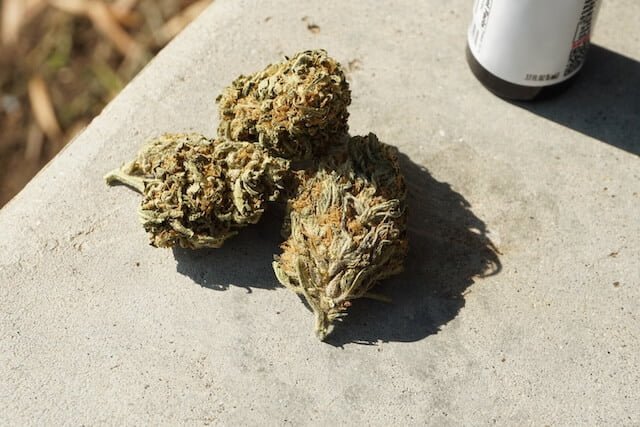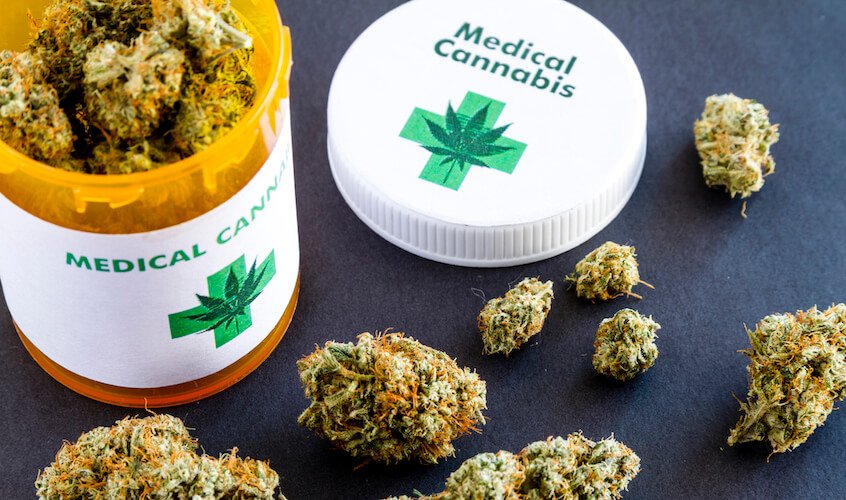Are you new to medicinal marijuana? Maybe you suffer from a particular condition and want to learn about an alternative plant-based treatment. Or perhaps you want to check why people are enthusiastic about the plant? If so, let me give you some insights into what medical marijuana is, how it affects your body, and its possible benefits.
I have organised the information into several topics:
How does Medicinal Marijuana interact with your body?
What are the conditions that Medicinal Marijuana can help you treat?
Here I will discuss the following:
- Chronic Pain
- Eating Disorders
- Amyotrophic Lateral Sclerosis (ALS)
- Parkinson’s Disease
- Epilepsy
- Anxiety and Depression
- Post-Traumatic Stress Disorder (PTSD)
- Nausea and Vomiting
Finally, I will inform you about the possible side effects and offer a Conclusion.
So, let us dive in.

The cannabis plant has been with us for millennia. Its medicinal properties have been well-known throughout the ancient world. Evidence of traditional medicine use has been uncovered in Japan, India, Iran, Egypt, the Roman Empire, Greece and the Arabian Peninsula. The first historical evidence of medicinal cannabis is documented in ancient China by Emperor Shen Nung in his Pharmacopoeia around 2800 BC. The texts show that the plant was used to treat rheumatic pain, constipation, arthritis, depression, amenorrhea, inflammation, lack of appetite, and asthma.
The use of cannabis in ritual ceremonies goes back even further. The first evidence is from around 7500-5500 BC in Proto-Indo-European tribes.
How does Medicinal Marijuana interact with your body?
First, let me clarify what medical marijuana is.
Simply put, medical marijuana or medical cannabis is a broad term for any product derived from the Cannabis Sativa L. plant prescribed to treat medical symptoms or conditions.
Cannabis Sativa contains over a hundred unique compounds called cannabinoids. The best-known and most commonly used are delta-9 tetrahydrocannabinol (THC) and cannabidiol (CBD). The delta-9 THC is the one making you high. CBD is not psychoactive and can be part of various therapeutics and cosmetics for general use.
These cannabinoids produce their therapeutic effects by interacting with your body’s endocannabinoid system (ECS).
What is the ECS, you ask?
The endocannabinoid system is responsible for our homeostasis – a process by which our bodies, as a set of biological systems, maintain stability to survive in the world. The system regulates appetite and digestion, sleep, pain sensation, mood, metabolism, learning and memory, reproduction, inflammation, and other immune responses. Meaning it is super important.
CB1 and CB2
The ECS comprises CB1 and CB2 receptors, endocannabinoids, and enzymes.
CB1 receptors are mainly present in the brain and spinal cord, which comprise the central nervous system. They act like traffic police at busy intersections by regulating incoming traffic and giving feedback to the brain. These actions let it know which systems to adjust, like hunger or temperature.
CB2 receptors are present in immune cells and the peripheral nervous system. They are vital to our immune health and regulate bowel function, pain and inflammation.
Here comes the fun part
Our bodies produce the so-called endocannabinoids to stimulate these receptors, which are similar to the molecules in the cannabis plant.
This means that we all have tiny cannabis-like molecules floating around our organisms.
These molecules can bind to the CB1 and CB2 receptors, producing various effects. For instance, endocannabinoids might target CB1 receptors in a spinal nerve to relieve pain. Others might bind to a CB2 receptor in our immune cells to signal that our body is experiencing inflammation, which might indicate an autoimmune disorder.
THC affects us by binding to the same receptors, essentially substituting the function of the endocannabinoids.
As for CBD, researchers are yet to understand how it interacts with the endocannabinoid system fully. They suspect that it might enhance the effects of the endocannabinoids by preventing them from breaking down.
Treatment with medical marijuana can be beneficial when the ECS shows signs of deficiencies. These can result in various conditions, from mild ailments to chronic illnesses. Some signs may be mood swings, insomnia, general nervousness, and gastrointestinal problems, among others.
What are the conditions that Medicinal Marijuana can help you treat?
Since the legalisation of medicinal use began in the early 2000s, research for the potential benefits and treatments has also increased.

Here I summarise my findings and include conditions based on information from reliable sources, relevant peer-reviewed studies, and clinical surveys.
So let’s see what modern science and medicine have figured out.
Disclaimer: Always consult your doctor about possible medical marijuana treatment and how it would interact with other prescribed medications.
1. Chronic pain
Some surveys show that more than 1.5 billion people worldwide suffer chronic pain. Consequently, one of the most common reasons people turn to medicinal marijuana is for pain management.
Many patients with underlying conditions like neuropathy, multiple sclerosis, rheumatoid arthritis, back injuries, cancer and chemotherapy-induced pain share that medical cannabis has improved their quality of life and has helped them manage their symptoms.
A 2017 National Academies of Sciences, Engineering, and Medicine (NASEM) report offers a cross-review of multiple research studies. These international studies include randomised controlled clinical trials involving a combined number of around 15,000 people – where one group receives a cannabinoid treatment, and another receives a placebo. The results show a reduction of pain in patients by about 40%. The effects are reported for all medical cannabis – smoking, vaping, oral ingestion, and topical application.
Another beneficial side of the plant-based treatment is relieving the side effects of prescribed opioids used to treat these conditions. People report that they feel less drowsy with fewer debilitating episodes. Some are also able to reduce and even stop using accompanying drugs.
A study published in the U.S. National Library of Medicine shows a 64% decrease in opioid use among chronic pain patients who use medicinal cannabis.
Another study reports a 17% reduction in opioid-related deaths. The researchers claim that medical marijuana also reduces related admissions to treatment centres.
Although clinical research is still needed, medicinal use shows great promise in treating various forms of chronic pain.
2. Eating Disorders
Eating disorders like Anorexia Nervosa are complex phenomena. They are often related to mental health issues and may co-occur with substance abuse. Because of this, they require a more comprehensive approach to treatment.
Along with the benefits of medical marijuana, people may need to make a fundamental change to their life – seek therapy, engage in healthy social interactions, exercise, and re-evaluate their relationship with food.
Nevertheless, plant medicine can benefit people suffering from eating disorders in two ways. It stimulates the insula – a brain section that integrates food sensory aspects like flavour, aroma, and texture. It also increases dopamine release in the body in response to food ingestion. In other words, it makes food taste better.

In addition, THC binds to CB1 receptors in the gut, which increases appetite. You might have heard the combination of these effects described as the munchies.
Several randomised clinical trial studies on anorexia support these findings. Groups of women were given different doses of THC over several weeks. In addition to the net weight gain of about 1kg per month, the participants reported increased pleasure from eating food and decreased anxiety and depression, which led to more calorie intake.
An interesting fact
Researchers assumed that since CB1 increases appetite, suppressing it should have the opposite effect. If true, this would help them treat obesity caused by compulsive eating or irresistible cravings for sweets and snacks. As a result, they developed the anti-obesity drug rimonabant, which was released in the European market.
Although it quickly led to significant weight loss, the drug was pulled from the market due to severe side effects like depression and suicidal thoughts. This shows the complicated relationship between food, appetite and our general well-being.
3. Amyotrophic Lateral Sclerosis (ALS)
ALS is a progressive nerve cell disease affecting the brain and the spinal cord. It causes loss of muscle control responsible for movement, speech, eating and breathing.
Research shows that medicinal marijuana can help reduce muscle stiffness and spasticity, improving quality of life.
Although researchers have made significant progress in understanding the disease, we still don’t know what causes it. There is no specific diagnostic test and no effective treatment either. It is up to your healthcare provider to consider your medical history and perform an examination to rule out other possible conditions.
So far, studies have identified a multitude of physiological factors and biological indicators that are involved with the occurrence of the disease.
Scientists need to develop a complex drug regimen to address them. They must include antioxidants, anti-inflammatory and antiapoptotic (cell death) agents, necrosis inhibitors, neuron growth and mitochondrial-enhancing factors.
Remarkably, medical cannabis appears to help in all of those areas. Preclinical data indicate that it can improve our immune system’s ability to fight pathogens. It is anti-inflammatory and has neuroprotective effects.
In a research study conducted by the California Pacific Medical Center in San Francisco, results show that THC and CBD have the ability to slow the damage ALS causes to the nerve cells and, in some cases, may be able to limit further damage, extending a patient’s life by three years or more. This may not seem like a lot, but remember that people diagnosed with ALS live for up to five years. As a comparison, one of the available drugs on the market – riluzole, extends life expectancy on average by about two months.
Another discovery by the California research team was that CBD could enhance THC benefits. Although CBD made no difference by itself, the combination of THC and CBD had even more potential in delaying ALS progression.
4. Parkinson’s Disease
Most treatment information is from patient surveys, observational studies, and small randomised placebo-controlled trials. However, the data is encouraging and shows benefits when treating Parkinson’s symptoms.
People smoking THC report improvement of motor and non-motor functions like hand-eye coordination, reduced difficulties with movement, flexibility, calming of the tremors and the erratic actions of the face and limbs, increased quality of sleep with fewer nightmares and nighttime interruptions, and reduced agitation with no severe side effects. They also noticed an improvement in memory, mood and energy levels.
These effects, however, were observed when the patients were exposed to prolonged treatment with medicinal marijuana, around two months on average, which suggests that the alternative medicine may need to act as a life-long treatment.
It was also observed that medical marijuana could improve the effect of accompanying prescribed drugs without worsening their side effects.
5. Epilepsy
Substantial evidence for the benefits of medical marijuana when treating epilepsy is the 2018 case of two children in the U.K. – Alfie Dingley and Billy Caldwell. The kids, who were 12 and 6 at the time, had severe epilepsy, and their parents treated them with cannabis oil. As a result, they showed a significant improvement in their condition. Unfortunately, due to the illegal status of the oil in the country, the medication was seized by the authorities. Consequently, in just a few days, Billy’s condition deteriorated to the point where he was admitted to a hospital with life-threatening seizures. This prompts the U.K. Home Office to grant a special license to the children, allowing them to use cannabis medicine.
Subsequently, Billy’s case gains national media coverage. With the help of local lobbying groups and social pushback, Health Secretary Jeremy Hunt announced that they’d be making changes to the law. On November 1st 2018, the medical use of cannabis was legalised.

Multiple clinical studies from the last decade also show the significant potential of medicinal marijuana, particularly CBD, in treating children and adults. The results indicate that the treatment reduces convulsions and episodes of epilepsy with some side effects, like fatigue and gastrointestinal disturbances. CBD has also been shown to provide significant neuroprotection and act as a potent antioxidant and anti-inflammatory molecule.
After the publication of the NASEM report, which I mentioned earlier under chronic pain, scientific evidence from a double-blind, randomised, placebo-controlled trial showed that cannabidiol (CBD) is effective in reducing motor seizures in children with Dravet syndrome, a severe type of epilepsy. It also offers great potential in treating patients with drug-resistant epilepsy.
In the future, this may prove to be a viable alternative to prescribed medications.
In the end, the studies establish that medical cannabis can be an effective and well-tolerated medicine for reducing seizures in children and adults suffering from intractable epilepsies.
6. Anxiety and Depression
The number one reported reason for self-treatment with marijuana is for relaxation and peace of mind.
In a sample study of 1,746 patients from a network of nine medical marijuana evaluation clinics in California, 37.8% reported using marijuana to relieve anxiety, 16.9% to relieve panic attacks, and 55.1% to improve relaxation.
Nevertheless, medical cannabis, anxiety and depression have a complicated relationship.
THC and CBD appear to have different effects concerning anxiety. Pure THC decreases anxiety at lower doses and increases it at higher doses. On the other hand, pure CBD reduces anxiety at all doses.
There seems to be tolerance to these effects over a short period with regular use. There are individual differences in responses to marijuana that are affected by a variety of factors. The most common use may be among those with social anxiety disorder.
In a published study in the Journal of Affective Disorders from August 2018, a scientist from Washington University concluded that medical cannabis users perceived a noticeable reduction in depression, anxiety and stress following immediate use. Just two breaths were sufficient to achieve the desired effect, while ten breaths produced the greatest perceived reductions in stress. Cannabis with high CBD and low THC content was associated with the most significant changes in depression ratings. In contrast, high CBD and high THC content cannabis produced the most significant perceived changes in stress. However, baseline symptoms of depression (but not anxiety or stress) appeared to be exacerbated after discontinued use.
In a 2018 study, participants who tried cannabis reduced the usage of commonly prescribed benzodiazepines by half.
7. Post-Traumatic Stress Disorder (PTSD)
A clinical research study from New Mexico is possibly the most cited example of the therapeutic use of medicinal marijuana for PTSD treatment. The reported patient results indicate an average reduction of 75% in all PTSD symptoms while using cannabis. These results are promising, especially for soldiers and veterans.

The Multidisciplinary Association for Psychedelic Studies (MAPS) published the results of a study of 150 participants in December 2020. They compare PTSD patients taking prescribed medical marijuana with others who do not use plant medicine for their symptoms. The results show that over a year, users experienced relief and a significant reduction in PTSD symptoms. They were also almost three times as likely to not meet the diagnostic criteria for PTSD as opposed to the other participants.
Medicinal cannabis can also help with traditional PTSD treatments like antidepressants and psychotherapeutic procedures that may have a partial effect and carry many unwanted side effects.
Research also shows that THC affects learning, memory and sleep architecture – meaning how the brain goes through different sleep cycles like deep sleep and REM sleep. This can help overcome negative intrusive memories, insomnia and nightmares.
In combination with the previously discussed qualities of relieving pain and anxiety, medicinal marijuana may lead PTSD patients to full recovery and allow them to live trauma-free lives.
8. Nausea and Vomiting
Although available prescription drugs are reliable for suppressing vomiting urges, nausea proves to be challenging. Symptoms are hard to control and anticipate. The feeling is also more stressful to patients because they might experience the symptoms over prolonged periods.
At the same time, marijuana’s antiemetic effects have been known for centuries. Medicinal use can help treat various forms of nausea related to gastrointestinal disorders, food poisoning, motion sickness, emotional distress, pregnancy, and even chemotherapy.
A 2021 study published in the Journal of Clinical Gastroenterology used a curious data-gathering method. From 2016 to 2019, researchers surveyed 886 people via the Releaf App – a mobile application where users can record their cannabis sessions anonymously and track symptoms in real-time. The results were based on 2,200 self-administration sessions dedicated to treating nausea. They showed that 96.4% of people experienced relief within an hour of smoking marijuana, which increased over time. Smoked Cannabis Sativa flower with high THC and low CBD content produced the most potent effect.
Recent evidence from animal tests also shows that medicinal cannabis can specifically benefit patients experiencing nausea from chemotherapy.
Another interesting fact that you might notice from the same evidence is that marijuana also treats nausea symptoms in animals.
Possible side effects
As with anything else, frequent cannabis use may lead to unwanted side effects. These depend on many factors like dosage and prescribed method of consumption, metabolism, existing conditions, weight, age, mental predisposition, etc.
Certain groups should avoid using marijuana for medicinal use, like children and adolescents, pregnant or breastfeeding women, people at risk of addiction or dependence, people with severe mental health, and heart and liver issues.
If you are new to medical cannabis, starting with a low dosage is always best and increasing it over time while monitoring its effects on you.
Although not a side effect per se, it is worth mentioning that medical marijuana is still an expensive treatment. Most conditions require multiple daily doses, and smoking, which is usually the cheapest option, is not always doctor-recommended.
In the United States, the average cost is about two thousand dollars per year, depending on the prescription. In addition, unlike other medications, medicinal cannabis may not be covered by insurance companies, leading to increased costs.
Physical side effects
Some physical side effects are red eyes due to increased eye pressure and changes in blood pressure and heart rate.
Medical cannabis may affect your concentration, orientation and motor skills, making it hard to drive or perform daily routines. Trace amounts of THC will also show on drug tests.

Another side effect is feeling drowsy or sleepy. This is most commonly related to the plant’s THC content. For instance, when smoking heavy Indica strains, the described feeling is couch-locked.
There are known instances of psychotic breaks and paranoia.
Maybe the most serious adverse effect is associated with male fertility. Since the endocannabinoid system is present in the male reproductive tract, medical marijuana may affect spermatogenesis – the sperm cell development process. It can also impact sperm functions like free movement and the ability to fertilise the egg.
A 2015 study published in the American Journal of Epidemiology examined 1,215 Danish males who had used cannabis in the past three months. The results showed that weekly use led to 28% lower sperm concentration and 29% lower total sperm count as opposed to non-users.
A 2019 review in the Journal of Urology shows that men who reported using cannabis demonstrate alterations in sperm count and concentration, morphology, energy metabolism, and fertilisation.
These studies do not discuss if these effects improve after the participants have stopped using cannabis.
Conclusion
Marijuana’s medicinal properties have been well-known since antiquity. Its active components, THC and CBD, interact with the receptors of our endocannabinoid system to produce their therapeutic effects.
Although more research is still needed, clinical studies have gained momentum over the past few decades. They show that medicinal marijuana can benefit various conditions like chronic pain, epilepsy, anorexia, anxiety, depression and PTSD.
The results also point to adverse side effects, so you should always consult your healthcare provider when considering treatment.
Do you want to learn more about medical marijuana? Email us or let us know in the comments what else you would like to read about!







Article Comments